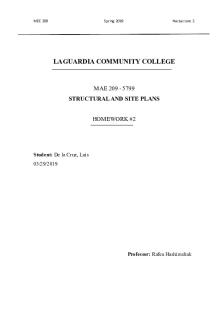Physics 154 Lecture 2 Notes and HW PDF

| Title | Physics 154 Lecture 2 Notes and HW |
|---|---|
| Course | Introductory Physics III |
| Institution | Drexel University |
| Pages | 11 |
| File Size | 1.2 MB |
| File Type | |
| Total Downloads | 71 |
| Total Views | 135 |
Summary
Lecture 2 notes and hw...
Description
-
No energy difference along an equipotential Electric field is always perpendicular to electric potential
-
Lot of energy with positive charge Energy sunken in negative charge
-
Goes to red - From green to red - Electrons roll uphill (electrically)
1. A charge +Q is placed at the origin. Which charge is at higher potential? A) A charge +q placed a distance r from the origin or B) A charge +2q placed a distance 2r from the origin A) q B) 2q C) Same potential ANSWER: A - Potential only depends on the source - They are equivalent in potential energy, but not potential - At first, we were contemplating option C, however, we realized that the question was asking about the potential and not potential energy. - Smaller r “wins”
1. A charge +Q is placed at the origin. Which charge is at higher potential energy? A) A charge +q placed a distance r from the origin or B) A charge +2q placed a distance 2r from the origin A) q B) 2q C) Same potential ANSWER: C - Potential depends on the charge of the source and object - After answering question one, we were careful in interpreting the difference between potential and potential energy. So we knew not to make the mistake and thus came to the agreement that option C was indeed the answer. - Potential energy depends on both charges
ANSWER: A - The forces cancel out in the middle since they are directly opposite, leaving no field - The potential would be negative in the middle if the charges were opposite - We were certain that the field would be zero, so we were between option A and option C. After realizing that the potential would be positive, we chose option A. - Each charge is pushing on the charge that might be placed in the center - Charges pushing at each other
-
ANSWER: ● Capacitance decreases ● Potential difference between plates increases ● Electric field between the plates stays the same ● Energy stored by the capacitor increases -
-
-
-
The capacitance increases because when the plates are separated the distance gets bigger. Thus using the relationship between C and d given in the equation for capacitance, we can see the inversely proportional relationship between both factors. The potential difference increases because of the relationship established in C=Q/V. The charge stays the same, however, we see that the V goes up when the C goes down because of the inversely proportional relationship. We were confused about this one, but then came to realize that the electric field stays the same because of how in the relationship established by the E=Q/e0A, A is given and Q is fixed, thus E is constant. We were slightly confused about this part of the question, because we did not know which direct relationship to look at. We then realized that with U=1/2QV, as the V went up, U went up to - thus a directly proportional relationship.
ANSWER: ● Capacitance decreases ● Potential difference between plates stays the same ● Electric field between the plates decreases ● Energy stored by the capacitor decreases -
The capacitance decreases for the same reason as in the previous problem The potential stays the same because the voltage fixed since it is supplied by the battery The electric field decreases since the overall capacitance decreases, meaning the charge decreases - C=Q/V The energy stored decreases since the charge decreases and the potential is fixed - U=1/2QV and Q went down, V is fixed The challenge in this problem was just making sure what happens when the voltage is constant and cannot vary as it typically does
QUESTIONS FROM LECTURE:
Dielectrics and Capacitors...
Similar Free PDFs

Physics 154 Lecture 2 Notes and HW
- 11 Pages

Hebreos - Lecture notes 154
- 9 Pages

HW #2 - Lecture notes 2.1
- 1 Pages

Soil Physics-Lecture notes -2
- 91 Pages

Nuclear physics lecture notes
- 55 Pages

MRS Physics - Lecture notes 2-14
- 29 Pages

Ch.2 Notes & HW
- 9 Pages

HW physics 2212
- 2 Pages

NUCLEAR PHYSICS- Lecture notes 17
- 13 Pages

Site planning Hw Lecture 2
- 8 Pages

Lecture notes, lecture 1 and 2
- 64 Pages

General Physics 2 Notes Rutgers
- 2 Pages

Physics Unit 2 Exam Notes
- 2 Pages
Popular Institutions
- Tinajero National High School - Annex
- Politeknik Caltex Riau
- Yokohama City University
- SGT University
- University of Al-Qadisiyah
- Divine Word College of Vigan
- Techniek College Rotterdam
- Universidade de Santiago
- Universiti Teknologi MARA Cawangan Johor Kampus Pasir Gudang
- Poltekkes Kemenkes Yogyakarta
- Baguio City National High School
- Colegio san marcos
- preparatoria uno
- Centro de Bachillerato Tecnológico Industrial y de Servicios No. 107
- Dalian Maritime University
- Quang Trung Secondary School
- Colegio Tecnológico en Informática
- Corporación Regional de Educación Superior
- Grupo CEDVA
- Dar Al Uloom University
- Centro de Estudios Preuniversitarios de la Universidad Nacional de Ingeniería
- 上智大学
- Aakash International School, Nuna Majara
- San Felipe Neri Catholic School
- Kang Chiao International School - New Taipei City
- Misamis Occidental National High School
- Institución Educativa Escuela Normal Juan Ladrilleros
- Kolehiyo ng Pantukan
- Batanes State College
- Instituto Continental
- Sekolah Menengah Kejuruan Kesehatan Kaltara (Tarakan)
- Colegio de La Inmaculada Concepcion - Cebu


